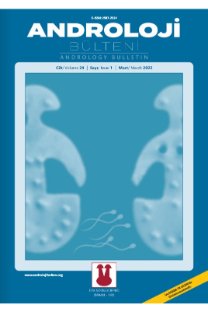Klinefelter sendromlu ve normal karyotipli hastaların testiküler sperm ekstraksiyonu sonuçlarının karşılaştılması: 10 yıllık tek merkez deneyimi
Comparison of testicular sperm extraction results in patients with klinefelter syndrome and normal karyotypes: 10 years single center experience
___
- 1. Corona G, Pizzocaro A, Lanfranco F, Garolla A, Pelliccione F, Vignozzi L, et al. On behalf of the Klinefelter Italian Group (KING). Sperm recovery and ICSI outcomes in Klinefelter syndrome: a systematic review and meta-analysis. Hum Reprod Update 2017;23:265–75. https://doi.org/10.1093/humupd/dmx008
- 2. Majzoub A, Arafa M, Al Said S, Agarwal A, Seif A, Al Naimi A, El Bardisi H. Outcome of testicular sperm extraction in nonmosaic Klinefelter syndrome patients: what is the best approach? Andrologia 2016;48:171–6. https://doi.org/10.1111/and.12428
- 3. Ozveri H, Kayabasoglu F, Demirel C, Donmez E. Outcomes of micro-dissection TESE in patients with non-mosaic Klinefelter’s syndrome without hormonal treatment. Int J Fertil Steril 2015;8:421–8.
- 4. Rohayem J, Fricke R, Czeloth K, Mallidis C, Wistuba J, Krallmann C, et al. Age and markers of Leydig cell function, but not of Sertoli cell function predict the success of sperm retrieval in adolescents and adults with Klinefelter’s syndrome. Andrology 2015;3:868– 75. https://doi.org/10.1111/andr.12067
- 5. Yucel C, Keskin MZ, Cakmak O, Ergani B, Kose C, Celik O, et al. Predictive value of pre‐operative inflammation‐based prognostic scores (neutrophil‐to‐lymphocyte ratio, platelet‐to‐lymphocyte ratio, and monocyte‐to‐eosinophil ratio) in testicular sperm extraction: a pilot study. Andrology 2017;5:1100–4. https://doi. org/10.1111/andr.12417
- 6. Aksglaede L, Juul A. Testicular function and fertility in men with Klinefelter syndrome: a review. Eur J Endocrinol 2013;168:67–76. https://doi.org/10.1530/EJE-12-0934
- 7. Schlegel PN. Testicular sperm extraction: microdissection improves sperm yield with minimal tissue excision. Hum Reprod 1999;14:131–5. https://doi.org/10.1093/humrep/14.1.131
- 8. Ustuner M, Yilmaz H, Yavuz U, Ciftci S, Saribacak A, Aynur BS, et al. Varicocele repair improves testicular histology in men with nonobstructive azoospermia. Biomed Res Int 2015:709452. https://doi.org/10.1155/2015/709452
- 9. Keskin MZ, Budak S, Köse C, Kaya ÖÖ, Özdemir TR, İlbey YÖ. Klinefelter sendromlu azospermik olgularda testiküler sperm ekstraksiyonu (TESE) başarısı için prediktif faktörler. Ege J Med 2016;55:51–4.
- 10. Sabbaghian M, Modarresi T, Hosseinifar H, Hosseini J, Farrahi F, Dadkhah F, et al. Comparison of sperm retrieval and intracytoplasmic sperm injection outcome in patients with and without Klinefelter syndrome. Urology 2014;83:107–10. https:// doi.org/10.1016/j.urology.2013.09.021
- 11. Bakircioglu ME, Ulug U, Erden HF, Tosun S, Bayram A, Ciray N, Bahceci M. Klinefelter syndrome: does it confer a bad prognosis in treatment of nonobstructive azoospermia? Fertil Steril 2011;95:1696–9. https://doi.org/10.1016/j. fertnstert.2011.01.005
- 12. Okada H, Goda K, Yamamoto Y, Sofikitis N, Miyagawa I, Mio Y, et al. Age as a limiting factor for successful sperm retrieval in patients with nonmosaic Klinefelter’s syndrome. Fertil Steril 2005;84:1662– 4. https://doi.org/10.1016/j.fertnstert.2005.05.053
- 13. Ferhi K, Avakian R, Griveau JF, Guille F. Age as only predictive factor for successful sperm recovery in patients with Klinefelter’s syndrome. Andrologia 2009;41:84–7. https://doi.org/10.1111/ j.1439-0272.2008.00875.x
- 14. Koga M, Tsujimura A, Takeyama M, Kiuchi H, Takao T, Miyagawa Y, et al. Clinical comparison of successful and failed microdissection testicular sperm extraction in patients with nonmosaic Klinefelter syndrome. Urology 2007;70:341–5. https://doi.org/10.1016/j. urology.2007.03.056
- 15. Turunc T, Gul U, Haydardedeoglu B, Bal N, Kuzgunbay B, Peskircioglu L, Ozkardes H. Conventional testicular sperm extraction combined with the microdissection technique in nonobstructive azoospermic patients: a prospective comparative study. Fertil Steril 2010;94:2157–60. https://doi.org/10.1016/j. fertnstert.2010.01.008
- 16. Ramasamy R, Lin K, Gosden LV, Rosenwaks Z, Palermo GD, Schlegel PN. High serum FSH levels in men with nonobstructive azoospermia does not affect success of microdissection testicular sperm extraction. Fertil Steril 2009;92:590–3. https://doi. org/10.1016/j.fertnstert.2008.07.1703
- ISSN: 2587-2524
- Yayın Aralığı: 4
- Başlangıç: 1999
- Yayıncı: Turgay Arık
Saadet Gonca Mavi AYDOĞDU, Ülkü ÖZSOY
Cerrahi menopoza giren genç kadınlarda cinsellik nasıl etkileniyor?
Metabolik sendrom ile ilişkili erektil disfonksiyonun medikal tedavisi
TÜRKİYE’DEKİ ANDROLOJİ YAYINLARI
Saygin M, Senol N, Cankara FN, Gokcay G, Altınok B, Özkan T, Çalışkan S, Keleş MO, Öztürk Mİ, Kutluhan MA, Tok OE, Marino L, Favre L, Liu X, Zhang JG
Cinsel perhiz süresi ve semen parametreleri arasındaki ilişki
Ahmet GÖKÇE, Deniz GÜL, Hacı Can DİREK, Hacı İbrahim ÇİMEN, Fikret HALİS
Cem YÜCEL, Orçun ÇELİK, Mehmet Zeynel KESKİN, Özgür ÇAKMAK, ÜLKÜ KÜÇÜK, Zafer KOZACIOĞLU
Varikosel cerrahisinde klinik başarı oranlarını etkileyen faktörler
ERHAN ATEŞ, MURAT UÇAR, Mehmet Zeynel KESKİN, İlter ALKAN, AHMET GÖKÇE
